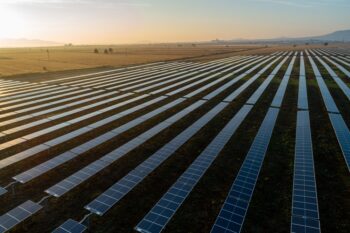Water Processes and Utility-Scale Solar Power Plants
Water use requirements for solar power plants depend on the technology and climate conditions at the site. In general, all solar power technologies use a modest amount of water (approximately 20 gallons per megawatt hour, or gal/MWh ) for cleaning solar collection and reflection surfaces like mirrors, heliostats, and photovoltaic (PV) panels. For comparison, a typical family uses about 20,000 gallons of water each year, more than the amount of water needed per MW of photovoltaic generation capacity.
In all thermal power plants, whether fossil, nuclear, or concentrating solar, heat is used to boil water into steam, which runs a steam turbine to generate electricity. The exhaust steam from the generator must be cooled prior to being heated again and turned back into steam.
This cooling can be done with water (wet cooling) or air (dry cooling), or a combination of both (hybrid cooling). Water cooling is the most efficient. CSP plants using parabolic trough or power tower technologies must use some form of cooling, while PV solar facilities do not require water for cooling.
Comparative Cooling Systems
Wet Cooling
Heat is dissipated from the power plant through evaporation, most often via a cooling tower. Wet cooling is the most common cooling method for power plants, as it is the most efficient and cheapest cooling method available. Wet-cooled parabolic troughs and power tower solar plants consume about the same amount of water as a coal-fired or nuclear power plant (500 to 800 gal/MWh).
Dry Cooling
Heat from the condenser is rejected using fans and ambient air. A significant temperature difference between the outside air and the exhaust steam is needed for an adequate heat exchange, limiting performance on hot summer days. Dry cooling systems have greater capital costs in comparison to wet cooling, but significantly reduce total water consumption (see chart above). Ivanpah Solar Electric Generating System uses dry cooling.
Hybrid Cooling
The hybrid approach involves constructing both a wet and a dry cooling system. These systems can either operate in parallel or switch from dry cooling to wet cooling during the hottest hours of the day. Hybrid systems conserve less water than dry cooling but are more expensive than either alone. Crescent Dunes Solar Energy Project uses hybrid cooling.
Water Use in Context: Utility-Scale Solar Power & Agriculture
- The Nevada Solar One parabolic trough plant consumes 850 gallons of water per MWh on a 360-acre site near Las Vegas, or about 300,000 gallons per acre per year. In comparison, agriculture in Nevada requires almost 1.2 million gallons of water per acre per year – nearly four times the consumption of the solar power plant.
- The Department of Energy compared the costs and benefits of the chief crop of the Imperial Valley area of California, alfalfa, to the benefits of potential parabolic trough solar plants. Researchers found the solar plant would use approximately 25 percent of the water required for a similar parcel of land growing alfalfa. Additionally, the USP plant was estimated to generate more revenue for the community and create more and higher-wage jobs.


